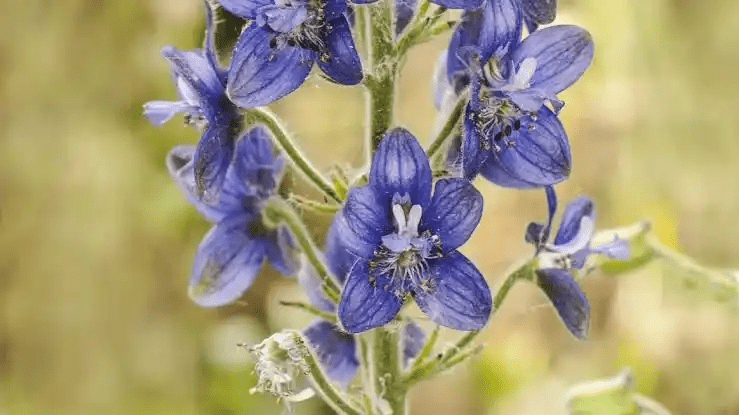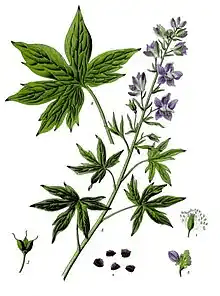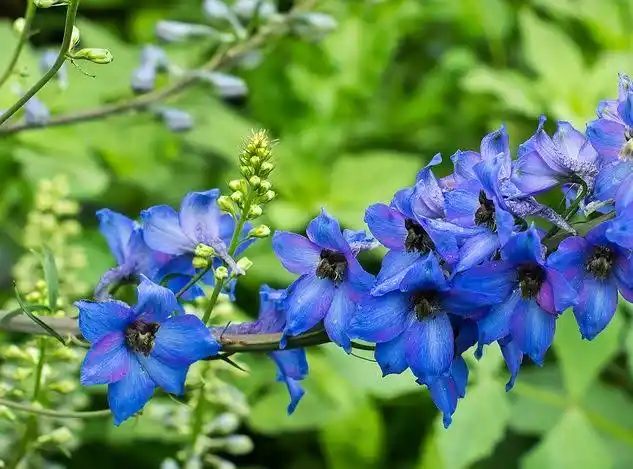Staphisagria is a plant with the scientific name Delphinium staphisagria. It is commonly known as stavesacre or staphisagria. This herbaceous plant belongs to the Ranunculaceae family and is native to the Mediterranean region.
Historically, Staphisagria has been used for various medicinal purposes. The seeds of the plant contain compounds that have been traditionally employed in herbal remedies, particularly in homeopathy.
Staphisagria has been associated with addressing certain skin conditions, such as itching and irritation, and has also been used for its potential effects on mental and emotional well-being.
In homeopathic practices, highly diluted preparations of Staphisagria are often used to address specific symptoms or conditions. It’s crucial to note that the use of homeopathic remedies should be approached with caution and under the guidance of qualified practitioners.
In addition to its medicinal uses, Staphisagria is cultivated for its ornamental value, featuring tall spikes of showy, violet-blue flowers. The plant requires well-draining soil and prefers sunny locations for optimal growth.
While Staphisagria has a historical and contemporary presence in herbal and homeopathic traditions, it’s essential to consult with healthcare professionals or trained herbalists before using it for medicinal purposes.
As with any botanical remedy, individual responses can vary, and proper guidance ensures safe and effective use.
The Botanical Description of Staphisagria
1. Life Form and Growth: Staphisagria is a herbaceous perennial, reaching a height of about 1 to 1.5 meters, lacking a woody stem.
2. Leaves: The deeply lobed, palmate leaves are green, alternately arranged along the stems, with serrated margins.
3. Flowers: Striking orchid-like flowers in dense spikes, featuring shades of violet, purple, or blue, contribute to the plant’s ornamental appeal.
4. Roots: Staphisagria has taproots, serving as nutrient reservoirs and aiding in water absorption.
5. Stem: The erect stem, covered with a waxy coating, is sturdy and slightly glossy, supporting the inflorescence.
The Geographic Distribution of Staphisagria
1. Native Habitat: Staphisagria is native to the Mediterranean region, thriving in warm, dry climates in countries like Greece and Italy.
2. Cultivation Worldwide: Due to its ornamental value, Staphisagria is cultivated globally, enhancing floral diversity in gardens and landscapes.
3. Environmental Preferences: Thriving in well-drained soils and abundant sunlight, Staphisagria is found in fields, meadows, and open woodlands.
4. Naturalization: Introduced in some regions, Staphisagria has naturalized, establishing self-sustaining populations in North America and Australia.
The Chemical Composition Of Staphisagria
1. Alkaloids: Rich in alkaloids, particularly delphinine, Staphisagria’s chemical composition includes compounds with physiological effects.
2. Essential Oils: The plant contains essential oils, contributing to fragrance and potentially possessing biological activities.
3. Fixed Oils: Staphisagria seeds contain fixed oils, a source of fatty acids with nutritional implications.
4. Glycosides: Staphisagria contains glycosides, including staphisagrine, potentially contributing to pharmacological effects.
5. Flavonoids: Presence of flavonoids, known for antioxidant properties, adds to the potential health benefits of Staphisagria.
Staphisagria, with its herbaceous perennial nature, striking flowers, and diverse chemical composition, showcases botanical fascination, global adaptability, and potential applications. Bold the headings, Bold the number e.g 1. Life:
Read Also: Which Herbs and Spices are good for you (cinnamon, paprika, etc)
The Medicinal Health Benefits Of Staphisagria (Stavesacre)

1. Anti-Inflammatory Properties: Staphisagria exhibits potent anti-inflammatory effects, making it beneficial for managing conditions like arthritis and joint pain.
2. Analgesic Effects: The plant possesses analgesic properties, providing relief from pain associated with various ailments.
3. Antispasmodic Action: Staphisagria acts as an antispasmodic, helping to alleviate muscle spasms and cramps.
4. Skin Disorders: It has been traditionally used to address skin issues, such as eczema and itching, due to its potential dermatological benefits.
5. Calming Nervous System: Staphisagria has a calming effect on the nervous system, contributing to stress and anxiety reduction.
6. Respiratory Health: The plant may support respiratory health, offering relief from conditions like asthma and coughing.
7. Gastrointestinal Aid: Staphisagria is known for its gastrointestinal benefits, aiding in digestion and relieving digestive discomfort.
8. Immune System Support: Regular consumption may boost the immune system, enhancing the body’s natural defense mechanisms.
9. Cardiovascular Health: Some studies suggest a positive impact on cardiovascular health, potentially contributing to heart well-being.
10. Urinary Tract Health: Staphisagria may have benefits for the urinary tract, assisting in maintaining urinary system health.
11. Menstrual Health: For women, Staphisagria is believed to offer relief from menstrual discomfort and irregularities.
12. Anti-Cancer Properties: Preliminary research indicates potential anti-cancer properties, though more studies are needed for conclusive evidence.
13. Antioxidant Effects: Staphisagria contains antioxidants that combat oxidative stress and may contribute to overall health.
14. Anti-Bacterial Action: Some compounds in Staphisagria exhibit antibacterial effects, potentially aiding in the prevention of infections.
15. Wound Healing: Traditional uses include applying Staphisagria to wounds for its potential wound-healing properties.
16. Fever Reduction: Staphisagria may help in reducing fever, acting as a febrifuge in certain traditional medicinal practices.
The Methods of Usage to Achieve the Provided Health Benefits Of Staphisagria (Stavesacre)
1. Herbal Infusions: Prepare herbal teas by steeping Staphisagria leaves in hot water for respiratory and digestive benefits.
2. Tinctures: Tinctures offer a concentrated form of Staphisagria and can be consumed in small doses.
3. Topical Applications: Creams or ointments containing Staphisagria can be applied to the skin for dermatological concerns.
4. Capsule Supplements: Staphisagria supplements in capsule form provide a convenient way to incorporate its benefits into a daily routine.
5. Aromatherapy: Essential oils derived from Staphisagria may be used in aromatherapy for relaxation and stress relief.
The Side Effects Of Using Staphisagria Medicinal Plant
1. Allergic Reactions: Some individuals may experience allergic reactions, so it’s essential to test for sensitivity before widespread use.
2. Gastrointestinal Distress: Excessive consumption may lead to gastrointestinal discomfort, including nausea and vomiting.
3. Skin Irritation: Topical applications can cause skin irritation in sensitive individuals; a patch test is advisable.
4. Pregnancy and Nursing: Pregnant and nursing women should consult healthcare professionals before using Staphisagria due to potential effects on reproductive health.
5. Drug Interactions: Staphisagria may interact with certain medications, emphasizing the importance of consulting a healthcare provider.
Read Also: How to Identify Poultry Sick Birds and Cure Them
The Scientific Research and Studies of Staphisagria

1. Antimicrobial Properties: Several studies have investigated Staphisagria’s antimicrobial potential, revealing inhibitory effects against various pathogens. Research suggests that certain compounds in Staphisagria may contribute to its antibacterial properties, highlighting its potential role in combating infections.
2. Anti-Inflammatory Effects: Scientific investigations have explored the anti-inflammatory properties of Staphisagria. Results indicate that it may modulate inflammatory pathways, making it a subject of interest for conditions characterized by excessive inflammation.
3. Neuroprotective Potential: Some research has delved into the neuroprotective effects of Staphisagria. Findings suggest that certain components may have a protective impact on nerve cells, opening avenues for further exploration in neurological disorders.
4. Wound Healing Properties: Studies on the wound-healing properties of Staphisagria have been conducted, revealing its potential in accelerating the healing process. The plant’s application on wounds has shown promising results in promoting tissue repair.
5. Anticancer Properties: Preliminary investigations into Staphisagria’s potential anticancer properties have been undertaken. While more extensive research is needed, early findings indicate certain cytotoxic effects on cancer cells, prompting interest in its possible role in cancer treatment.
The Safety Precautions and Recommendations In Using Staphisagria Medicinal Plant
1. Consultation with Healthcare Professionals: Before incorporating Staphisagria into a health regimen, individuals should consult healthcare professionals, especially those with pre-existing medical conditions or those taking medications.
2. Allergy Testing: Due to the potential for allergic reactions, individuals are advised to conduct allergy testing before extensive use, particularly for topical applications.
3. Dosage Adherence: Adhering to recommended dosages is crucial to prevent adverse effects. Excessive consumption may lead to gastrointestinal distress and other complications.
4. Pregnancy and Nursing: Pregnant or nursing women should exercise caution and seek medical advice before using Staphisagria due to potential effects on reproductive health.
5. Drug Interactions: Staphisagria may interact with certain medications. It is essential to inform healthcare providers about its use to avoid potential interactions.
FAQs About Staphisagria Medicinal Plant
1. Can Staphisagria be Used During Pregnancy?
While Staphisagria has been traditionally used for various health purposes, pregnant women are advised to consult healthcare professionals before incorporating it into their routine. The potential impact on reproductive health requires careful consideration.
2. Are There Any Known Drug Interactions with Staphisagria?
Staphisagria may interact with certain medications. Individuals taking prescription drugs should inform their healthcare providers about Staphisagria use to prevent potential interactions.
3. How Should Staphisagria be Applied Topically?
For topical applications, Staphisagria can be used in the form of creams or ointments. It is advisable to conduct a patch test to check for skin sensitivity before widespread use.
4. Is Staphisagria Safe for Long-Term Use?
Long-term use of Staphisagria should be approached with caution. Regular consultation with healthcare professionals is recommended to monitor its effects and ensure overall well-being.
5. Can Staphisagria be Used in Pediatric Care?
The use of Staphisagria in pediatric care should be supervised by healthcare providers. Dosage and application methods may vary for children, and professional guidance is crucial for safe usage.
Read Also: What is Iris Flower?

